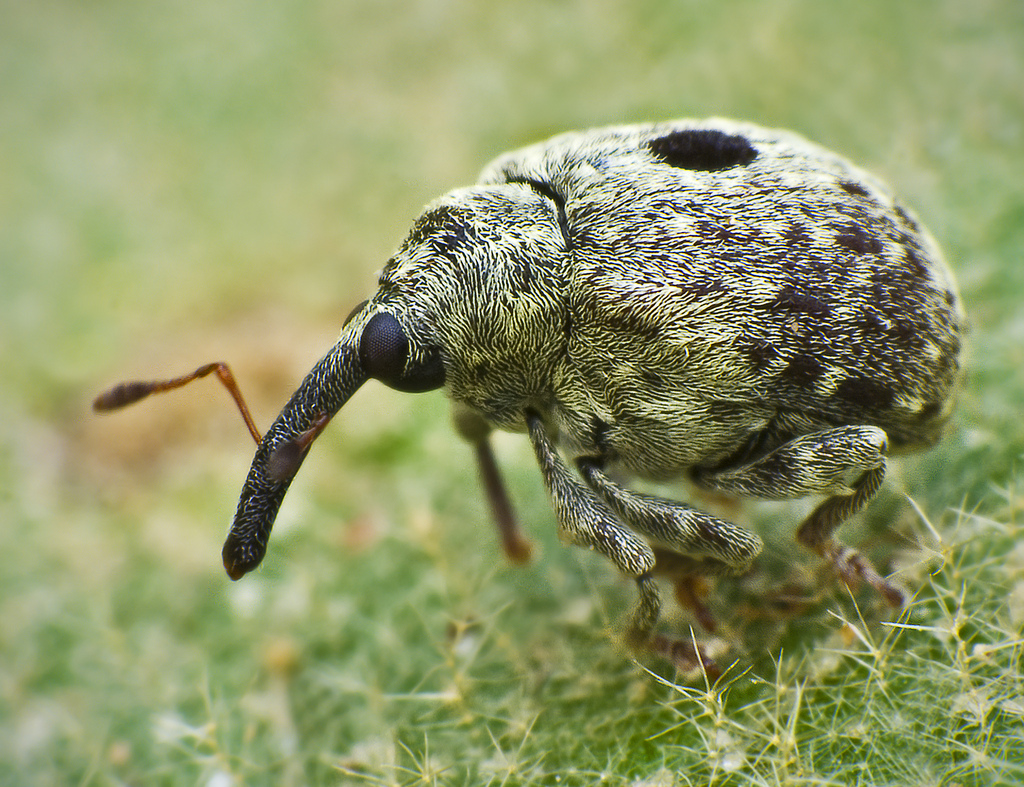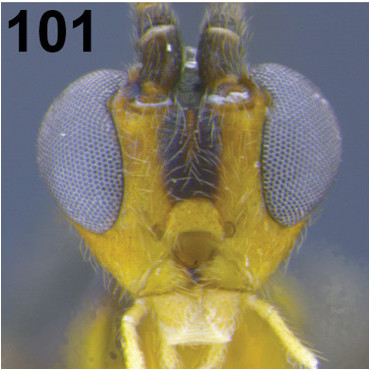|
Cylindrocopturus Adspersus
''Cylindrocopturus adspersus'', the sunflower stem weevil, is a species of true weevil in the beetle family Curculionidae. It is found in North America, where the larvae tunnel in the stems of wild and cultivated sunflower plants. Description The adult sunflower stem weevil is about long and a grayish-brown color with irregular whitish markings. The larva is creamy white with a brown head. Ecology The adults emerge from their over-wintering chamber in old sunflower stumps in May or June and feeds on sunflower leaves, doing no significant damage. When ready to breed, the female chews a hole in the base of a sunflower stem and inserts a single egg, protecting it with frass. The larva feeds inside the stem and when fully developed descends to the base of the plant and hollows out a chamber in the woody tissue. It is this excavation that weakens the stem. The main parasitoid of the larva of the sunflower stem weevil is ''Nealiolus curculionis'', a braconid wasp. The female of th ... [...More Info...] [...Related Items...] OR: [Wikipedia] [Google] [Baidu] |
John Lawrence LeConte
John Lawrence LeConte (May 13, 1825 – November 15, 1883) was an American entomologist of the 19th century, responsible for naming and describing approximately half of the insect taxa known in the United States during his lifetime,Bird Name Biographies - URL retrieved September 14, 2006 including some 5,000 of beetles. He was recognized as the foremost authority on North American s during his lifetime, and has been described as "the father of American beetle study".Evans, Arthur V., and James N. Hogue. 2004. Chapter 1: A Brief History of Beetle Study in California. ... [...More Info...] [...Related Items...] OR: [Wikipedia] [Google] [Baidu] |
Curculionidae
The Curculionidae are a family of weevils, commonly called snout beetles or true weevils. They are one of the largest animal families, with 6,800 genera and 83,000 species described worldwide. They are the sister group to the family Brentidae. They include the bark beetles as the subfamily Scolytinae, which are modified in shape in accordance with their wood-boring lifestyle. They do not much resemble other weevils, so they were traditionally considered a distinct family, Scolytidae. The family also includes the ambrosia beetles, of which the present-day subfamily Platypodinae was formerly considered the distinct family Platypodidae. Description Adult Curculionidae can be recognised by the well-developed, downwards-curved snout (Rostrum (anatomy), rostrum) possessed by many species, though the rostrum is sometimes short (e.g. Entiminae). They have elbowed Antenna (biology), antennae that end in clubs, and the first antennal segment often fits into a groove in the side of the ros ... [...More Info...] [...Related Items...] OR: [Wikipedia] [Google] [Baidu] |
Frass
Frass refers loosely to the more or less solid excreta of insects, and to certain other related matter. Definition and etymology ''Frass'' is an informal term and accordingly it is variously used and variously defined. It is derived from the German word ''Fraß'', which means the food takeup of an animal.M. Clark and O. Thyen. The Oxford-Duden German Dictionary. Publisher: Oxford University Press 1999. The English usage applies to excreted residues of anything that insects had eaten, and similarly, to other chewed or mined refuse that insects leave behind. It does not generally refer to fluids such as honeydew, but the point does not generally arise, and is largely ignored in this article. Such usage in English originated in the mid-nineteenth century at the latest. Modern technical English sources differ on the precise definition, though there is little actual direct contradiction on the practical realities. One glossary from the early twentieth century speaks of "...excreme ... [...More Info...] [...Related Items...] OR: [Wikipedia] [Google] [Baidu] |
Parasitoid
In evolutionary ecology, a parasitoid is an organism that lives in close association with its host (biology), host at the host's expense, eventually resulting in the death of the host. Parasitoidism is one of six major evolutionarily stable strategy, evolutionary strategies within parasitism, distinguished by the fatal prognosis for the host, which makes the strategy close to predation. Among parasitoids, strategies range from living inside the host (''endoparasitism''), allowing it to continue growing before emerging as an adult, to Paralysis, paralysing the host and living outside it (''ectoparasitism''). Hosts can include other parasitoids, resulting in hyperparasitism; in the case of oak galls, up to five levels of parasitism are possible. Some parasitoids Behavior-altering parasite, influence their host's behaviour in ways that favour the propagation of the parasitoid. Parasitoids are found in a variety of Taxon, taxa across the insect superorder Endopterygota, whose compl ... [...More Info...] [...Related Items...] OR: [Wikipedia] [Google] [Baidu] |
Nealiolus Curculionis
''Nealiolus curculionis'' is a species of parasitic wasp in the family Braconidae. It is a parasitoid of the sunflower stem weevil '' Cylindrocopturus adspersus'', and a number of other species of stem-boring weevils. Description ''Nealiolus curculionis'' has a body length of just under . It has an oval shape, a moderately-curved carapace and a transverse clypeus, and the third tergite is finely sculpted with longitudinal lines. The color is basically black apart from the legs, which are brown, the dark brown antennae, the brown clypeus and mandibles, the brown ovipositor and the dark brown tip of the abdomen. Distribution This wasp is found in Canada, the United States and Mexico, and has also been recorded in Costa Rica, Guatemala and Venezuela. Life cycle This wasp shows a considerable degree of synchronization with its host species. When parasitizing the sunflower stem weevil, the female wasp lays a single egg into a first instar larva, which feeds just under the epid ... [...More Info...] [...Related Items...] OR: [Wikipedia] [Google] [Baidu] |
Braconidae
The Braconidae are a family of parasitoid wasps. After the closely related Ichneumonidae, braconids make up the second-largest family in the order Hymenoptera, with about 17,000 recognized species and many thousands more undescribed. One analysis estimated a total between 30,000 and 50,000, and another provided a narrower estimate between 42,000 and 43,000 species. Classification The Braconidae are currently divided into about 47 subfamilies and over 1000 genera, which include '' Aerophilus'', '' Aleiodes'', '' Apanteles'', '' Asobara'', '' Bracon'', '' Cenocoelius'', '' Chaenusa'', '' Chorebus'', ''Cotesia'', '' Dacnusa'', ''Diachasma'', ''Microgaster'', '' Opius'', '' Parapanteles'', '' Phaenocarpa'', '' Spathius'', and '' Syntretus.'' These fall into two major groups, informally called the cyclostomes and noncyclostomes. In cyclostome braconids, the labrum and the lower part of the clypeus are concave with respect to the upper clypeus and the dorsal margin of the mandi ... [...More Info...] [...Related Items...] OR: [Wikipedia] [Google] [Baidu] |
Instar
An instar (, from the Latin '' īnstar'', "form", "likeness") is a developmental stage of arthropods, such as insects, between each moult (''ecdysis''), until sexual maturity is reached. Arthropods must shed the exoskeleton in order to grow or assume a new form. Differences between instars can often be seen in altered body proportions, colors, patterns, changes in the number of body segments or head width. After shedding their exoskeleton (moulting), the juvenile arthropods continue in their life cycle until they either pupate or moult again. The instar period of growth is fixed; however, in some insects, like the salvinia stem-borer moth, the number of instars depends on early larval nutrition. Some arthropods can continue to moult after sexual maturity, but the stages between these subsequent moults are generally not called instars. For most insect species, an ''instar'' is the developmental stage of the larval forms of holometabolous (complete metamorphism) or nymphal ... [...More Info...] [...Related Items...] OR: [Wikipedia] [Google] [Baidu] |
Diapause
In animal dormancy, diapause is the delay in development in response to regular and recurring periods of adverse environmental conditions.Tauber, M.J., Tauber, C.A., Masaki, S. (1986) ''Seasonal Adaptations of Insects''. Oxford University Press It is a physiological state with very specific initiating and inhibiting conditions. The mechanism is a means of surviving predictable, unfavorable environmental conditions, such as temperature extremes, drought, or reduced food availability. Diapause is observed in all the life stages of arthropods, especially insects. Embryonic diapause, a somewhat similar phenomenon, occurs in over 130 species of mammals, possibly even in humans, and in the embryos of many of the oviparous species of fish in the order Cyprinodontiformes. Activity levels of diapausing stages can vary considerably among species. Diapause may occur in a completely immobile stage, such as the pupae and eggs, or it may occur in very active stages that undergo extensive migrati ... [...More Info...] [...Related Items...] OR: [Wikipedia] [Google] [Baidu] |
Macrophomina Phaseolina
''Macrophomina phaseolina'' is a Botryosphaeriaceae plant pathogen fungus that causes damping off, seedling blight, collar rot, stem rot, charcoal rot, basal stem rot, and root rot on many plant species. Hosts, symptoms, and signs One of the most harmful seed and soil borne pathogens, ''Macrophomina phaseolina'' is a fungus that infects nearly 500 plant species in more than 100 families. The hosts include: peanut, cabbage, pepper, chickpea, soybean, sunflower, sweet potato, alfalfa, sesame, potato, sorghum, wheat, and corn, among others. The identification of isolates of ''M. phaseolina'' is usually based on morphology and efforts to divide the pathogen into subspecies, but because there are wide intraspecific variations in the phenotype of the isolates, these criteria are often not reliable. The failure to correctly detect and identify ''M. phaseolina'' using conventional culture-based morphological techniques has led scientists to develop nucleic acid-based molecular approac ... [...More Info...] [...Related Items...] OR: [Wikipedia] [Google] [Baidu] |
Fusarium Solani
''Fusarium solani'' is a species complex of at least 26 closely related filamentous fungi in the division Ascomycota, family Nectriaceae. It is the anamorph of ''Nectria haematococca''. It is a common soil fungus and colonist of plant materials. ''Fusarium solani'' is implicated in plant disease as well as human disease notably infection of the cornea of the eye. History and taxonomy The genus ''Fusarium'' was described in 1809 by Link. In the 1930s, Wollenweber and Reinking organized the genus ''Fusarium'' into sections, including ''Martiella'' and ''Ventricosum,'' which were collapsed together by Snyder and Hansen in the 1940s to form a single species, ''Fusarium solani;'' one of nine ''Fusarium'' species they recognized based on morphological features. The current concept of ''F. solani'' is as a species complex consisting of multiple, closely related and morphologically poorly distinguishable, "cryptic" species with characteristic genetic differences. There is a proposed co ... [...More Info...] [...Related Items...] OR: [Wikipedia] [Google] [Baidu] |
Articles Created By Qbugbot
Article often refers to: * Article (grammar), a grammatical element used to indicate definiteness or indefiniteness * Article (publishing), a piece of nonfictional prose that is an independent part of a publication Article may also refer to: Government and law * Article (European Union), articles of treaties of the European Union * Articles of association, the regulations governing a company, used in India, the UK and other countries * Articles of clerkship, the contract accepted to become an articled clerk * Articles of Confederation, the predecessor to the current United States Constitution * Article of Impeachment, a formal document and charge used for impeachment in the United States * Articles of incorporation, for corporations, U.S. equivalent of articles of association * Articles of organization, for limited liability organizations, a U.S. equivalent of articles of association Other uses * Article, an HTML element, delimited by the tags and * Article of clothing, ... [...More Info...] [...Related Items...] OR: [Wikipedia] [Google] [Baidu] |







